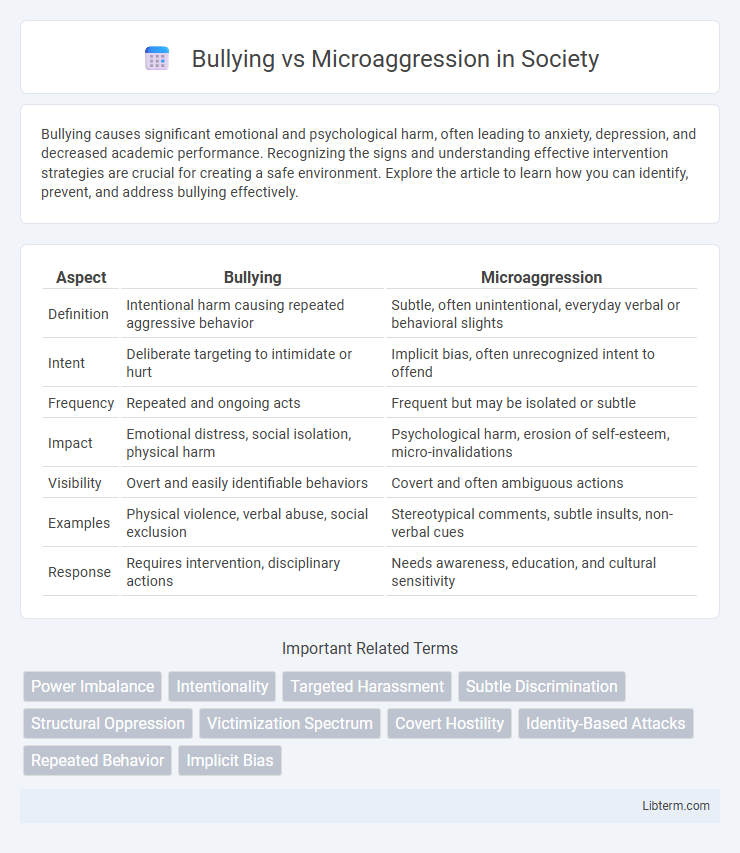Bullying causes significant emotional and psychological harm, often leading to anxiety, depression, and decreased academic performance. Recognizing the signs and understanding effective intervention strategies are crucial for creating a safe environment. Explore the article to learn how you can identify, prevent, and address bullying effectively.
Table of Comparison
| Aspect | Bullying | Microaggression |
|---|---|---|
| Definition | Intentional harm causing repeated aggressive behavior | Subtle, often unintentional, everyday verbal or behavioral slights |
| Intent | Deliberate targeting to intimidate or hurt | Implicit bias, often unrecognized intent to offend |
| Frequency | Repeated and ongoing acts | Frequent but may be isolated or subtle |
| Impact | Emotional distress, social isolation, physical harm | Psychological harm, erosion of self-esteem, micro-invalidations |
| Visibility | Overt and easily identifiable behaviors | Covert and often ambiguous actions |
| Examples | Physical violence, verbal abuse, social exclusion | Stereotypical comments, subtle insults, non-verbal cues |
| Response | Requires intervention, disciplinary actions | Needs awareness, education, and cultural sensitivity |
Understanding Bullying: Definition and Key Characteristics
Bullying is a deliberate, repeated aggressive behavior intended to harm, intimidate, or control another person, often characterized by a power imbalance between the aggressor and the victim. Key characteristics include physical, verbal, or relational abuse that occurs consistently over time, causing emotional or psychological distress. Understanding bullying requires recognizing its persistence, intent to cause harm, and the unequal power dynamics involved in these interactions.
What Are Microaggressions? An Overview
Microaggressions are subtle, often unintentional, verbal or nonverbal actions that convey derogatory or negative messages to marginalized groups. These behaviors can include brief comments, gestures, or environmental slights that reflect implicit biases and reinforce social inequalities. Unlike overt bullying, microaggressions are typically indirect but accumulate harm over time by undermining the recipient's dignity and sense of belonging.
The Psychological Impact: Bullying vs Microaggressions
Bullying often causes overt psychological harm such as anxiety, depression, and lowered self-esteem due to repeated, intentional aggressive behavior. Microaggressions, though subtle and often unintentional, accumulate over time and contribute to chronic stress, feelings of alienation, and internalized negativity, which can severely impact mental health. Both forms of social aggression disrupt emotional well-being, but microaggressions tend to create lasting psychological scars by undermining identity and belonging in marginalized groups.
Types of Bullying and Microaggressions in Everyday Life
Types of bullying include physical aggression, verbal harassment, social exclusion, and cyberbullying, each causing varying levels of harm and psychological distress. Microaggressions manifest as subtle, often unintentional, verbal, behavioral, or environmental slights that communicate derogatory or negative messages toward marginalized groups. Common microaggressions include assumptions about intelligence, cultural insensitivity, and invalidation of experiences, all contributing to a cumulative impact on mental health and social dynamics.
Intent vs. Impact: Distinguishing the Two Behaviors
Bullying involves intentional actions aimed at causing harm or intimidation, whereas microaggressions often stem from unconscious biases despite their harmful effects. The impact of both behaviors can lead to psychological distress, but understanding intent helps differentiate deliberate cruelty from subtle, often unintentional offenses. Addressing these issues requires recognizing that microaggressions may not be intended to harm, yet their cumulative impact can be equally damaging as bullying.
Power Dynamics: How Context Shapes Both Actions
Bullying involves overt acts of aggression where power imbalances are clear and intentional, often targeting individuals with perceived vulnerabilities. Microaggressions are subtle, often unconscious, expressions of bias embedded in everyday interactions, reflecting systemic power disparities rather than explicit intent. Contextual factors such as social hierarchy, cultural norms, and institutional structures critically shape how both bullying and microaggressions manifest and impact victims.
Common Examples: Bullying and Microaggressions Compared
Bullying commonly includes overt actions such as physical intimidation, verbal abuse, and exclusion intended to harm or control the victim. Microaggressions are subtle, often unintentional, behaviors or remarks like offhand comments, stereotypes, or dismissive gestures that undermine a person's identity or experience. Both create hostile environments, but bullying is typically explicit and aggressive, while microaggressions operate through indirect, everyday interactions.
Recognizing the Signs: Spotting Bullying and Microaggressive Behavior
Recognizing the signs of bullying and microaggressive behavior requires attention to both overt and subtle actions, including repeated verbal insults, exclusion, or harmful teasing for bullying, and indirect comments or behaviors that subtly demean or marginalize an individual based on identity in microaggressions. Bullying often involves clear intention to harm or dominate, while microaggressions might appear unintentional, yet still cause psychological distress and perpetuate stereotypes. Identifying patterns such as sudden changes in mood, withdrawal, or decreased performance can indicate exposure to either form of mistreatment, necessitating timely intervention.
Prevention and Intervention Strategies
Effective prevention of bullying and microaggressions involves implementing comprehensive educational programs that promote empathy, diversity awareness, and respectful communication among students and employees. Intervention strategies emphasize timely identification and response through clear reporting mechanisms, restorative justice practices, and support services like counseling to address the emotional impact on victims. Establishing strong institutional policies and training for educators and managers ensures consistent enforcement and fosters a safe, inclusive environment.
Fostering Respectful Environments: Moving Beyond Harm
Fostering respectful environments involves understanding the distinct nature of bullying and microaggressions while addressing their impact on individuals. Bullying often entails repeated, overt aggressive behavior that harms or intimidates, whereas microaggressions are subtle, often unintentional acts that convey disrespect or bias. Implementing policies and open communication channels enhances awareness, encourages empathy, and promotes inclusivity, ultimately moving beyond harm to cultivate safe spaces for all.
Bullying Infographic

 libterm.com
libterm.com